Opinion
Kenny Schachter Needed New Art Like a Hole in the Head at Art Basel, But Dug Up Plenty of Priceless Intel Instead
Our dauntless columnist ventured once more into the Swiss fair's intrigue-packed aisles, bringing back the goods.
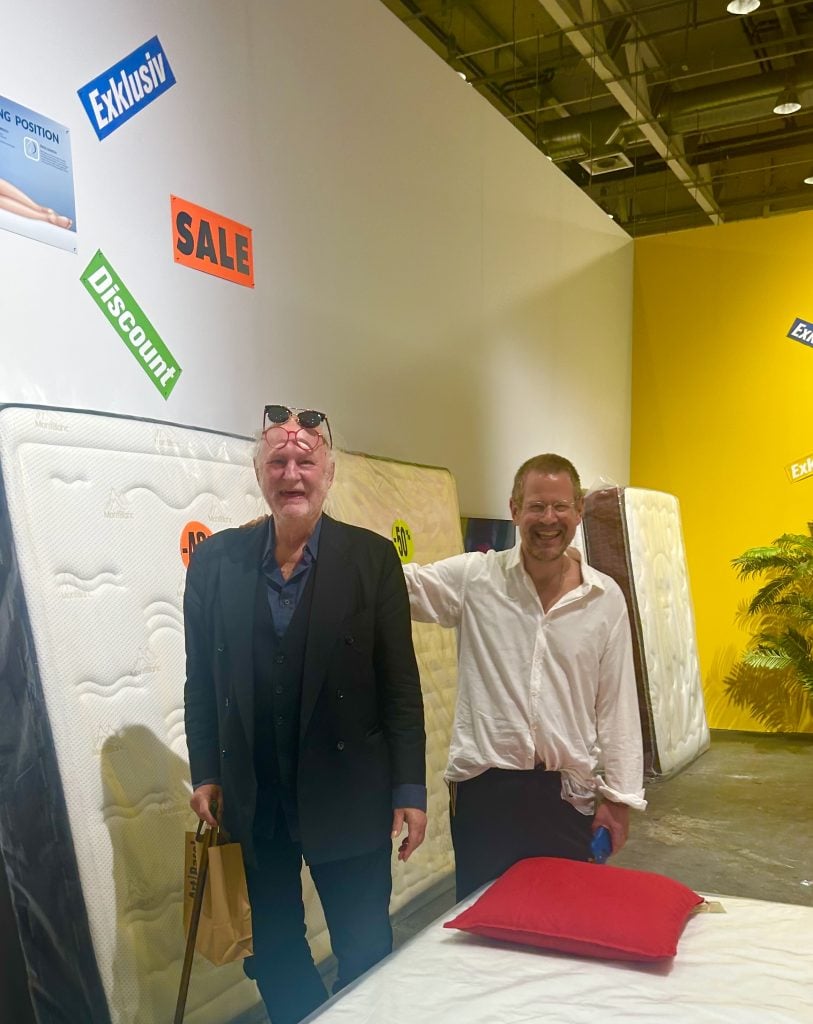
Our dauntless columnist ventured once more into the Swiss fair's intrigue-packed aisles, bringing back the goods.

Kenny Schachter

I started my Swiss sojourn two weeks ago in Zurich for a series of talks on, you guessed it, NFTs: their marketplace and the art form (it’s that too but don’t worry, I won’t bend your ear with that now). First off was a blockchain conference at the University of Zurich, where I’ve been teaching for over a decade and serve on the advisory board, and where I managed to get into an argument with Lana Swartz—asynchronically anyway, since she spoke before me. Lana is the author of a book on money, and I begged to differ with her viewpoint that pretty much everything is a scam, from crypto to art to the state of Florida, where selling swampland as developable property dates back to 1925. I can assure you that, regarding grift in the art market, at least, it’s not as prevalent as she thinks—you can even find bona fide art in Art Basel Miami Beach, provided you look hard enough.
The two lectures were part of the second annual NFT Art Day, which kicked off in a co-working complex called Trust Square at Paradeplatz. Ok, I’ll take the easy joke: applied to NFTs and crypto, you can’t even trust that Trust Square isn’t a circle. I was 30 minutes late to my own talk as I couldn’t find a taxi—I am fastidiously always on time, but I was guesting at a friend’s, the historian Georg Frei (who spent 20 years writing the first volume of Warhol’s catalogue raisonné, which only encompassed 1961-63, and bowed out after volume two), and he lives outside the city center. Though the event was billed as a small workshop, I raced up the stairs, flustered and in a sweat, to find myself in a room of nearly 100 people expecting a full-blown presentation from me. I had none.
Never one to shy away from a captive audience—no one listens to me on the homefront anymore—I sprang into action and regaled the audience with tales of the art world and my NFT adventures over the past three years with no more than a single slide. The following day, I was billed as the solo keynote speaker to launch a daylong symposium of panels for a full auditorium in David Chipperfield’s extension to the Kunsthaus Museum—something I had actually spent weeks preparing for, and a situation I normally thrive in. Unfortunately for my audience, there’s always an exception.
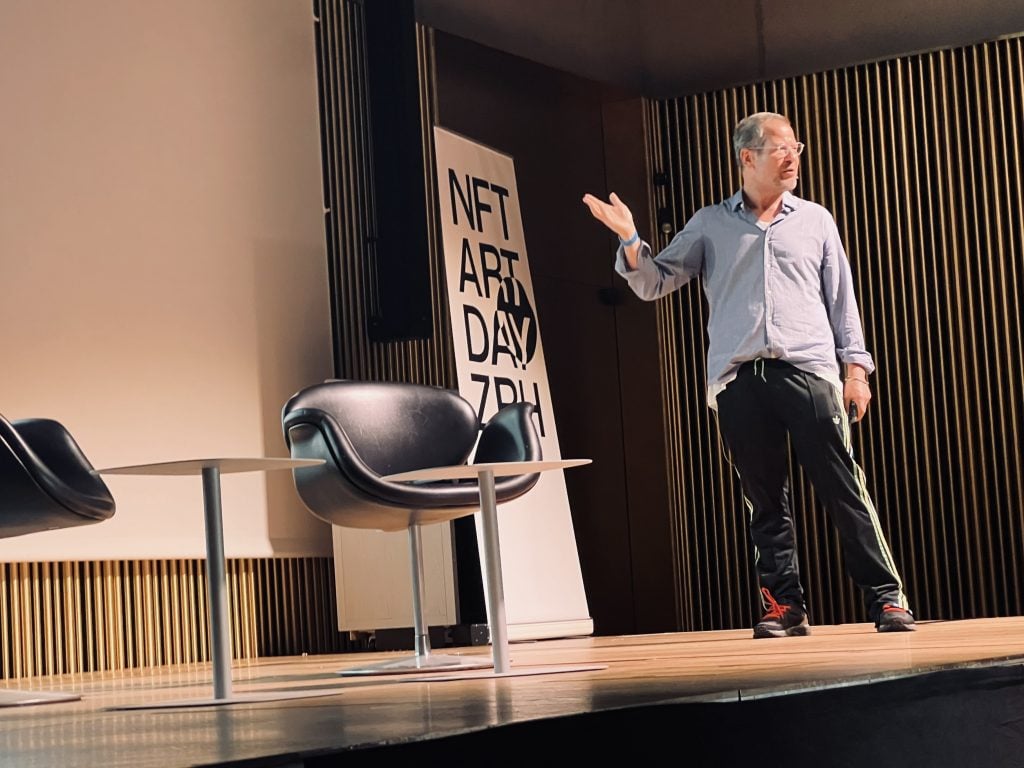
Choke! Can’t win ‘em all, and this certainly wasn’t my best performance. Oh well, till next time. Courtesy of Kenny Schachter.
The problem is, I hate to have close friends (or family) on hand when I lecture, and in this instance Georg showed up and my slide clicker didn’t. After it malfunctioned, so did I. I performed in a textbook bell’s curve compared to the previous day, and after my keynote half a dozen spectators felt compelled to inform me that I did a worse job. Everyone’s a critic, even more so with a critic.
Don’t worry: after making you suffer through the travails of my professional speaking engagements, I’ll now reward you with some intel on the fair and goings-on in Basel. But first, in keeping with the general economic malaise we are undoubtedly in the midst of, I wangled a free room in the Marriot near the convention center after having endured a broken air conditioner there last year. That plus crashing at Georg’s saved a nice pile of cash.
But, illustrating the truism that there’s no such thing as a free lunch, I punctured my scalp (replete with gushing blood) on the corner of an open window frame above my Basel bed as I was getting up in the morning. Perfect! En route to the opening of the fair I resembled Matt Collishaw’s infamous 1988 work Bullet Hole—depicting depicted a mortal icepick wound to a victim’s head—that launched the YBA movement. Needless to say, I’m angling for another free room next year.
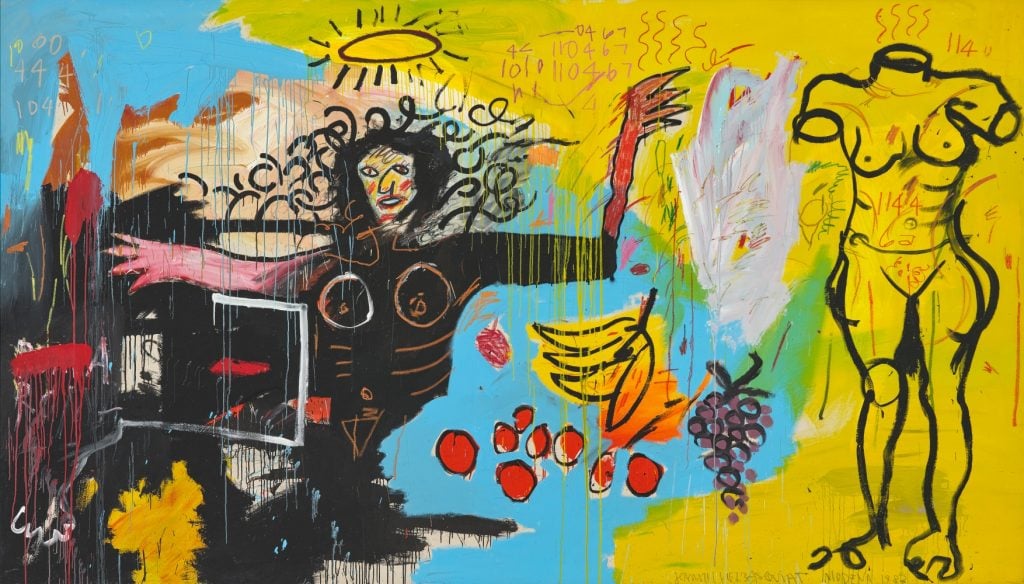
Jean-Michel Basquiat, Untitled (Woman with Roman Torso [Venus]) (1982), at the Beyeler show. Photo: Robert Bayer, © Estate of Jean-Michel Basquiat, licensed by Artestar, New York.
It was well reported that the Chinese were back in force at Basel, even though a recent Financial Times headline blared: “Chinese economic data fuels gloom over recovery.” Of the non-gloomy Chinese buyers, I bumped into Lin Li, a phenomenally successful young fashion entrepreneur with an outsized collection and foundation in Hangzhou, where I hope to do a project next year. There seemed to be less Americans on hand, which surely must have pleased Belgian Alain Servais, who prefers “real people.”
The pomposity of that ascot-wearing hot-airbag (he’ll surely stipulate in his will to be buried in a neckerchief) showed no abatement with his nonsensical comment in relation to the unwieldy installations in the Unlimited section of the fair, including a giant mattress shop by Guillaume Bijl: “It’s never the fault of the fair, it’s the fault of the buyers,” he said. “Galleries are going to bring what they think they can sell.” In reality, there was next to no sellable fare in the Unlimited section other than a stupid candy-striped computer-generated glass cross by Gerhard Richter.
Speaking of Richter, David Zwirner had an imposing blood-red abstraction, 747-4 (Gerhard has an oh-so-German way with his titles), with an asking price of $24m—it last fetched $21.5 million at Sotheby’s in 2014 and remained unsold at Basel at the time of this writing. Michael Werner had a Sigmar Polke masterpiece for the bargain basement price of $9 million, consigned by spec-u-lector Howard Rachofsky (who I recently reported had been selling a Christina Quarles and other works previously promised as museum gifts). Since the Polke was also unsold at press time, maybe Howard should give it to an institution as a make-good, and for the write-off.
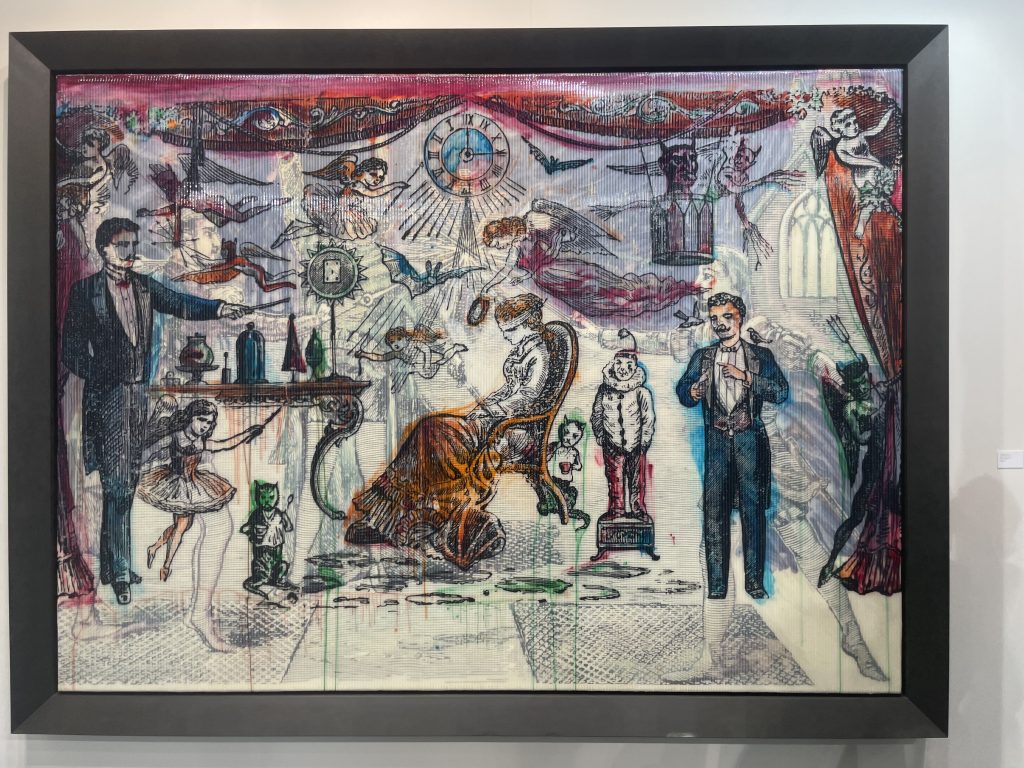
The Sigmar Polke consigned by Howard Rachofsky and unsold at $9 million but worth twice as much were it not for estate issues. Photo by Kenny Schachter.
Incidentally, that Polke painting, which took three years to make, should have had twice the asking price and might have had the artist not died intestate—no will was found, anyway—with an intransigent wife who disbanded the estate and currently won’t even grant image rights to museums. There’s not even a catalogue raisonné in the works. Polke is a genius of 20th-century art for both his extreme, experimental processes in materials and ironic conceptual gestures. I strongly covet his work, from his prints and photographs to his films, multiples, and canvases.
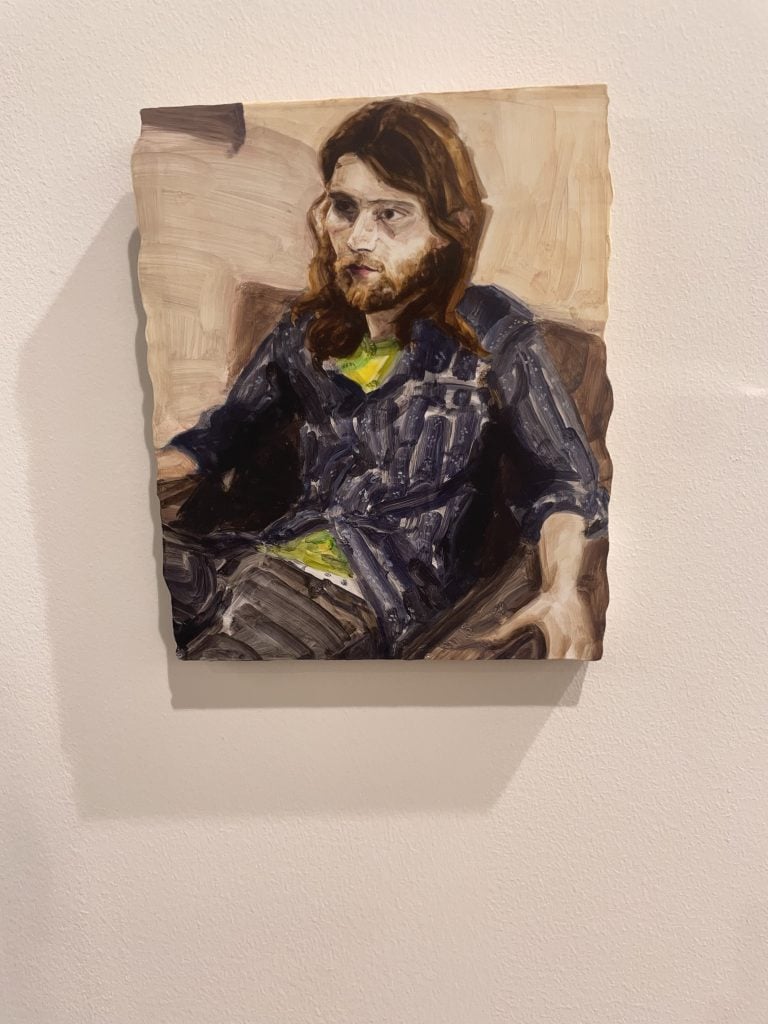
Elizabeth Peyton, the size of postage stamp, the price of a house, though unsold at $1 million when I wrote this. Photo by Kenny Schachter.
Before I mention a few artworks that actually were sold at Basel, add to the unsold list (at least at the time of this writing) a secondary-market Elizabeth Peyton priced a $1 million, a $250,000 Matthew Barney, and a $110,000 Rachel Harrison, all at Regen Projects in LA; a $70,000 Richard Tuttle at Stuart Shave’s Modern Art; and a very cool André Cadere at Berlin’s Galerie Neu for €280,000. Cadere was an artist after my own heart, rocking up uninvited to exhibitions with his portable works in hand.
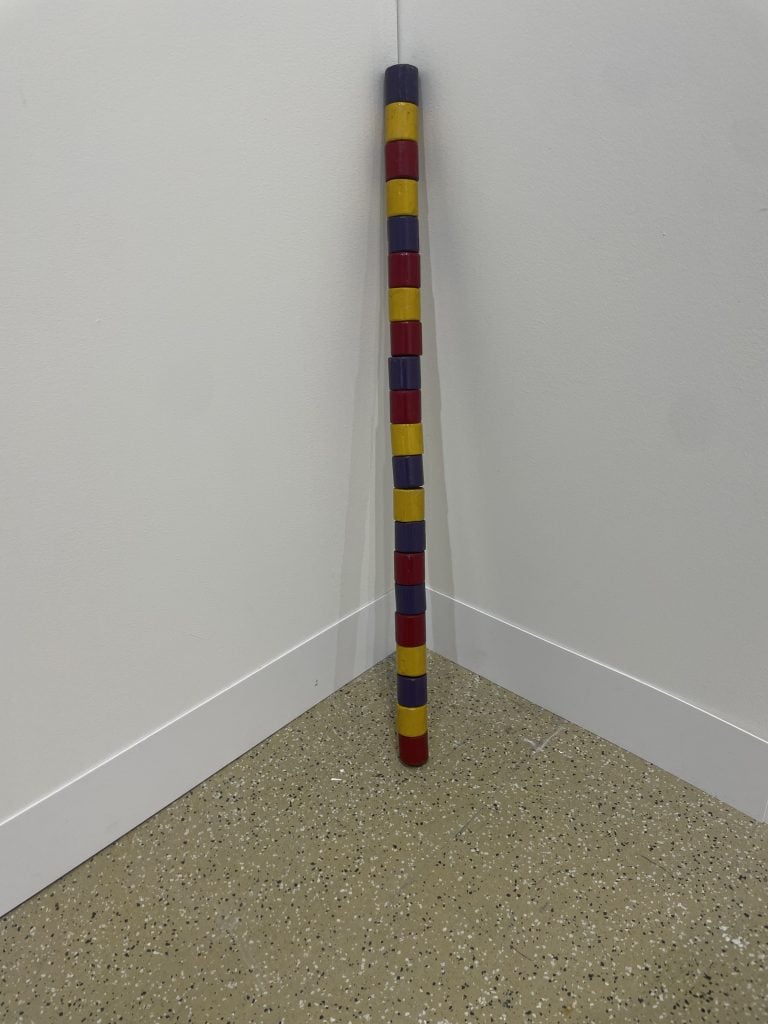
Andre Cadere at Berlin’s Neu Galerie; have art—will show up at your exhibit, unannounced, and be a participant by default. I want one. Now.
Photo by Kenny Schachter.
A few choice works that did sell—I thought of making a t-shirt “It was…” for the way dealers talk about the prices of snapped-up art—include $110,000 mixed-media work by Tisham Hsu at Miguel Abreu and a $75,000 Allison Katz painting at Gio Marconi. British collector Ed Lee snagged a Maria Lassnig work for €650,000 at Petzel—I know because he told me so on the checkout line at the Marriot, relating he felt he got a good deal since Hauser & Wirth had one for $2.5 million.
Raphaela Vogel’s 2021 sculpture at Berlin’s BQ gallery was entitled There Are Indeed Medium-Sized Narratives; maybe there are, but this gigantic work was comprised of two life-sized giraffes astride two refrigerators and wasn’t one of them. It was, though, purchased by dealer Johann König—yes, that one—for €85,000.
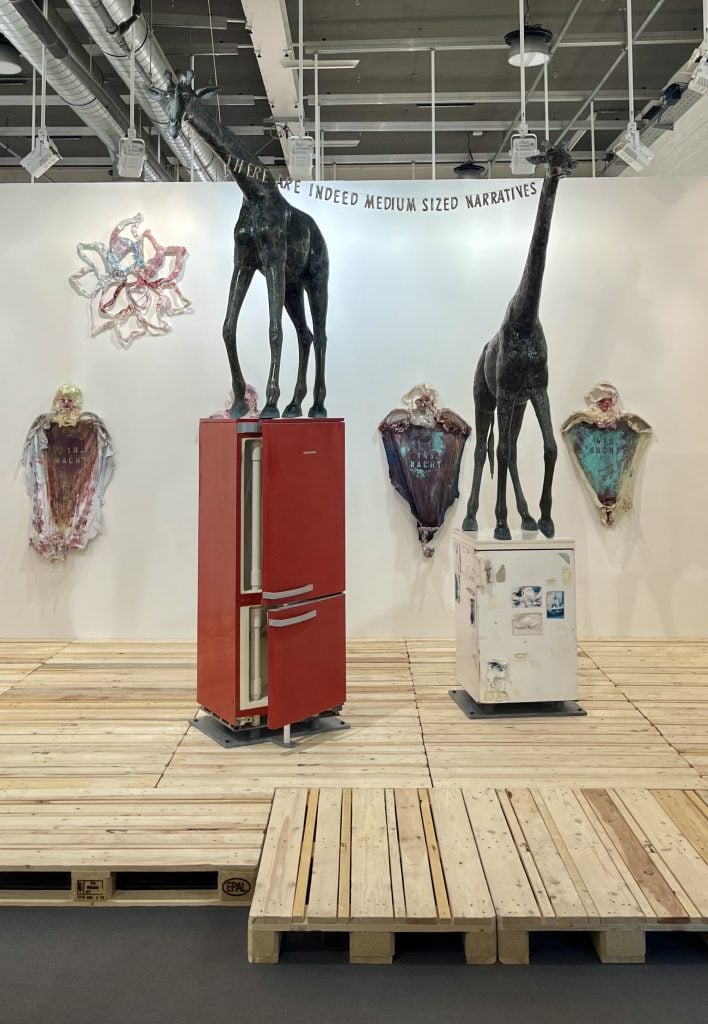
Raphaela Vogel’s work is named There Are Indeed Medium-Sized Narratives but this isn’t one of them—and it was bought by beleaguered art dealer Johann König. Photo by Kenny Schachter.
Johann told me it was “painful” being (indefinitely) rejected from the fair after allegations of sexual misconduct in the German Newspaper Die Zeit, and that he wasn’t even sent a VIP pass for entrance to the proceedings this go-round. Everyone is innocent until proven guilty, and a recent article, “The Case of Johann König: Why Die Zeit Should Never Have Published Their Article,” is at least worth a read.
After the unexpected, untimely death of dealer Ted Bonin, Alexander and Bonin Gallery is now slated to close. I loved Ted, not simply because he represented my favorite artist, dead or alive, Paul Thek, but rather because he was super knowledgeable, passionate, and kind—traits in short supply in today’s art world. I approached Matthew Marks in the street (which took a lot of courage, as he always blanks me despite us knowing each other decades) and asked whether he would pick up the Thek estate, to which he replied, “NO!”—through gritted teeth.
Neither Hauser nor Zwirner, which recently sold a sculpture for $3 million to Mitchell Rales’s Glenstone Foundation, has requested to step into the Thek breach thus far. There’s an as yet unannounced (till now) retrospective at the Kunsthaus Zurich coming up in late 2024 and I for one can’t wait, having been involved in the 2009 Reina Sofia show (which originated at the ZKM in Karlsruhe and Falckenberg Collection in Hamburg) and the Whitney’s 2010 exhibition.
Uncharacteristically, I bought nothing at the fair this year—I’m under a self-imposed moratorium, or, more to the point, cashless. My standstill was in spite of the scientifically proven medicinal qualities of making and living with art (see the following Harvard University study). Nevertheless, I didn’t leave empty-handed—I met two art handlers from my Zurich storage facility prior to departure to facilitate the withdrawal of two Issy Wood paintings. Old habits die hard.

I couldn’t afford anything new this time around, but there’s plenty enough piled in my storages. And they deliver. To the airport. For a not-insubstantial cost. Photo by Kenny Schachter.